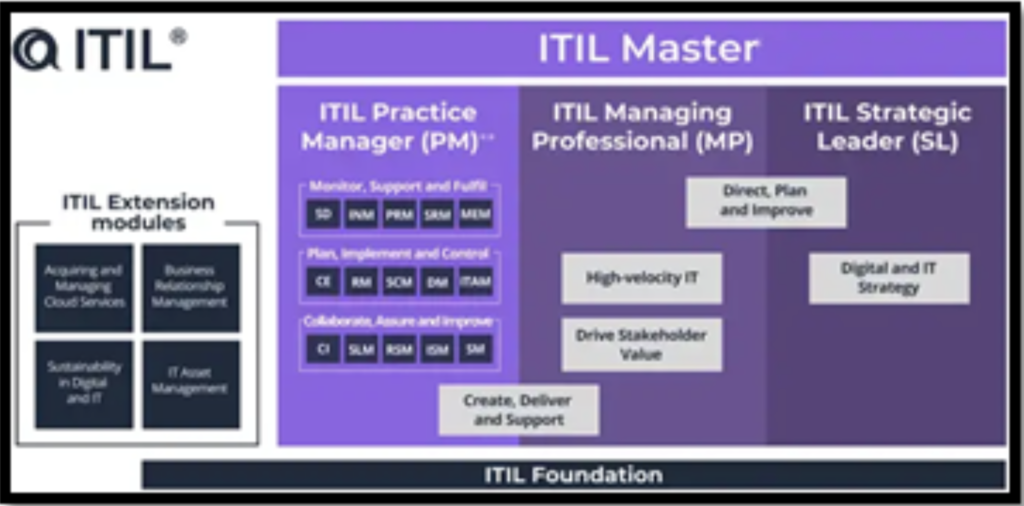In ITIL, Enterprise Architecture mostly covers the following domains: Business, Information, Applications, and Technology.
“ITIL Architecture Management is seen as a subset of the whole Enterprise Architecture Framework”
In ITIL AM you will learn the Definition, Objective, Roles, and Activities of Architecture Management as an ITIL® Process.
ITIL Architecture Management process isn’t officially defined as a process in ITIL Service Design. ITIL official training doesn’t describe much detail about the process although this framework is used throughout the ITIL lifecycle to reflect an organisation’s standard technology architecture.
ITIL Architecture Management Process assists in verifying that the services and products reflect the defined baseline Enterprise Architecture – hence the name.
Discussing this topic here should provide you some explanation. This article wouldn’t be discussing it in-depth but should provide you enough information for an ITIL Foundation Examination.
ITIL Architecture Management’s Objective:
The primary objective of ITIL Architecture Management is to define and continuously verify the baseline technological development of the future, accounting for the organisation’s service strategy and new technology capabilities.
The Sub-Process of ITIL-AM (ITIL ARCH-MGMT)

Some Terminologies and Definitions:
Enterprise Architecture (EA):
“An Enterprise Architecture (EA) is a description of the essential components of a business, including their interrelationships.”
In ITIL, Enterprise Architecture covers the following domains mostly: Business,
Information,
Applications, and
Technology.
ITIL Architecture Management is a subset of the whole Enterprise Architecture Framework.
The Application Framework promotes reusable components or application modules and assists standardising the technologies on which applications are based and defines classes of applications with common (NFR) non-functional requirements. It must be planned and maintained separately. It does not get managed together with software development projects. However, it has to also be aligned with the software developers’ requirements.
Change Request to Enterprise Architecture:
“A request to change or extend the Enterprise Architecture.”
These are issued from any of the Service Design processes when the introduction or modification of a service is not reflected or possible within the constraints of the existing architectural baseline design.
ITIL Architecture Management Roles and Responsibilities:
The Enterprise Architects role is the Process Owner of ITIL Architecture Management Process and is responsible for maintaining the Enterprise Architecture (EA).
“In Larger organizations, there may also be separate EA roles having special domain knowledge, such as Business Architect, Application Architect, Information Architect, or Infrastructure Architect.”
If you enjoyed this article about Architecture Management – ITIL Process stay tuned for our subsequent blogs. Leave us some comments if you have any questions or are unsure about the ITIL Enterprise Architecture Management framework (as defined in ITIL). If you like our article, please see our Facebook and Twitter pages as well to get notifications on recent and updated contents.
Suggested Reading:
10 Best ITIL Books to Pass ITIL Foundation Exam on Your First Attempt
List of All ITIL Roles and Responsibilities – Process Wise
ITSM vs ITIL: What’s the Difference?

ITIL 4 MANAGING PROFESSIONAL, ITIL 4 STRATEGIC LEADER, ITIL 4 ITIL 4 PRACTICE MANAGER, EXTENSION MODULES and ITIL4 MASTER
As can be seen from this blog, ITIL, if interpreted and applied correctly, can help to optimise any organisation’s journey to a fully-fledged digital business model in ways that are cost effective and highly efficient.
In WiRD’s experience, many organisations who have invested resources in ITIL, are only using a fraction of the wisdom and capabilities. It can be a very powerful enabler of digital transformation enabled by formal enterprise architecture. What has your experience been in this regard? How effectively is your organisation using its investment in ITIL? How are the ITIL resources applying themselves to continuously improve their environment. Service delivery remains the key component for generating value.
Our subsequent blogs will elaborate on ITIL key areas and concepts.
